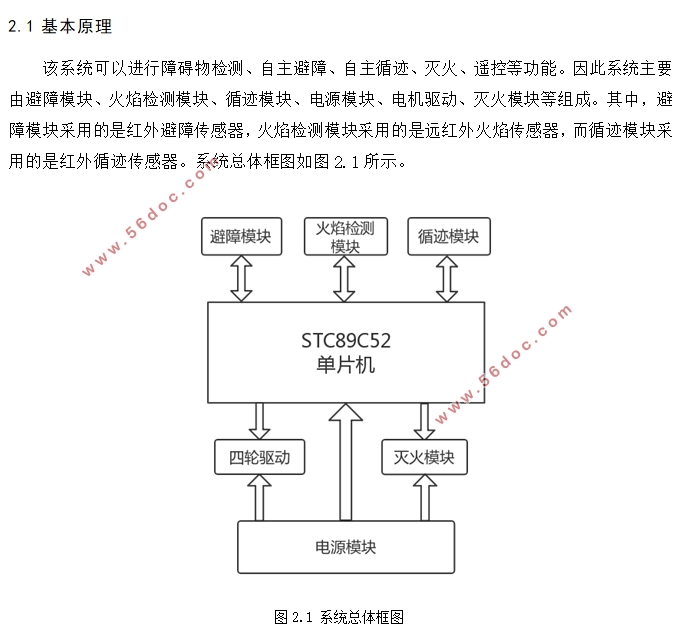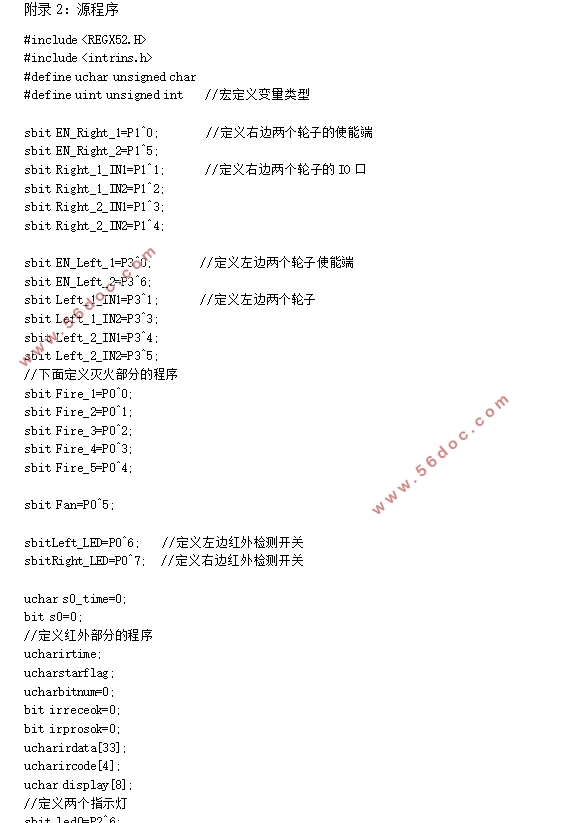基于STC89C52单片机的循迹避障灭火小车的设计
来源:56doc.com 资料编号:5D25673 资料等级:★★★★★ %E8%B5%84%E6%96%99%E7%BC%96%E5%8F%B7%EF%BC%9A5D25673
资料以网页介绍的为准,下载后不会有水印.资料仅供学习参考之用. 密 保 惠 帮助
资料介绍
基于STC89C52单片机的循迹避障灭火小车的设计(论文18000字)
摘要:本次课题设计了一款基于STC89C52单片机的智能循迹避障灭火小车。该系统由微处理器、红外避障传感器、火焰传感器、红外循迹传感器、电源模块、电机驱动模块、直流电机、灭火模块等模块组成。该小车避障模块通过红外避障传感器进行障碍物检测从而实现避障功能。循迹模块通过红外循迹传感器采集黑线信号,并传送至系统,从而沿着黑线行进。红外火焰传感器用于检测屋内是否有火源,当检测到火源后小车就会立刻停止,并驱动单片机启动风扇灭火。另外有红外遥控器可以单独控制小车的方向。
关键词:STC89C52;循迹模块;红外避障;红外遥控
A Tracking, Avoiding Obstacle and Extinguishing Vehicle Based On STC89C52 Micro-controller
Abstract:This project has designed a smartvehicle which can track and follow the black line, avoid the obstacles and extinguish the fire. The whole system consists of a microprocessor,infrared obstacle avoidancesensors,flame sensors, infrared tracking sensors, power module,motor drive module,direct current machine, fire extinguishing module and so on. The obstacle avoidance sensorcan detect the obstaclesin front of the smart vehicle to realize the obstacle avoidance function.The infrared tracking sensordetects the black line signal and then sends the signal to the system to follow the black line.The infrared flame sensors are used to detect whether there is a fire source in the room.When the fire source is detected, the vehicle will stop immediately and give signals to the micro-controller to start fans to extinguish the fire in front of the vehicle.In addition, there is an infrared remote controller to individually control the direction of thevehicle.
Key words:STC89C52; tracking module; infrared obstacle avoidance; infrared remote control



目 录
1 绪论 1
1.1 课题开发背景 1
1.2 研究现状 1
1.3 课题研究意义 2
1.4 课题研究内容 2
2 系统基本原理与方案设计 3
2.1 基本原理 3
2.2 中央处理模块设计方案 3
2.3 避障模块设计方案 4
2.4 火焰检测模块设计方案 6
2.5 灭火模块设计方案 8
3 系统硬件设计 9
3.1 单片机系统 9
3.1.1 单片机STC89C52 9
3.1.2 STC89C52单片机最小系统 10
3.2 电机驱动模块 11
3.3 避障模块 14
3.4 火焰检测模块 15
3.5 循迹模块 16
3.6 电源模块 18
3.7 灭火模块 19
4 软件设计 20
4.1 开发环境 20
4.2 程序介绍 20
4.3 流程图 21
5 系统调试 24
5.1 实物介绍 24
5.2 存在的问题 27
6 总结与展望 27
6.1 总结 28
6.2 展望 28
参考文献 29
致谢 30
附录1:整体电路图 31
附录2:源程序 32
|







